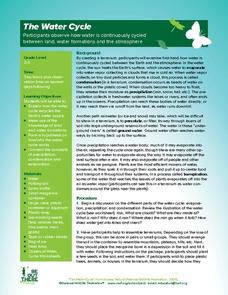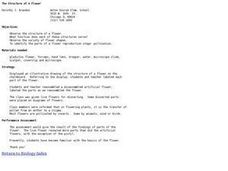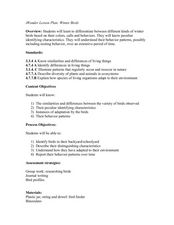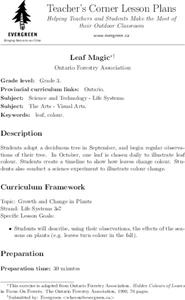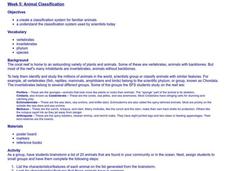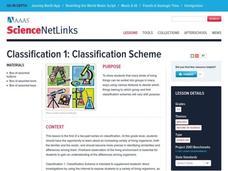Curated OER
Field Biology
Students work with 4th and 5th graders at Cascade Brook School in Farmington, to teach them skills in wildflower and fern identification, and then to help them implement a nature trail, which is accessible to the greater Farmington...
Curated OER
Flowers, Flowers, Flowers...A Visit with Georgia O'Keeffe
Students analyze, discuss, and research Georgia O'Keeffe and her flower paintings. They select a flower to paint and create a watercolor painting in the style of Georgia O'Keeffe. Students compose a poem describing their painting.
Curated OER
The Water Cycle
Learners are introduced to the components and importance of the water cycle. They are shown how groundwater moves using a model. Students list 9 places on earth where water is found. They define the terms cycle and water cycle.
Curated OER
Farmers and the Food Connection
Learners investigate the process of growing food. In this agricultural activity, students invite a farmer into their classroom to discuss how they grow and process food. Learners participate in learning centers which focus on farming.
Curated OER
Lesson 3 - Water Above the Ground
Students define surface water, drainage basin or watershed. They investigate what affects runoff in a drainage basin. They complete lab sheets and worksheets.
Curated OER
The Structure of A Flower
Students study the structure of flowers. In this biology lesson plan, students observe the structure of a flower and find out what function each of the structures serve.
Curated OER
Mapping a Garden
Second graders recognize the components of a map, particularly the legend, the key, the symbols and the area. They develop their own map of a garden they be planting in their upcoming science lesson.
Alabama Learning Exchange
"Nuts" about Peanuts!
Students describe the characteristics of a peanut and peanut butter using their five senses. They record their observations and descriptions on a graphic organizer. They may use the Internet to look up answers to questions about peanuts...
Curated OER
North American Butterflies and Moths of Fields, Meadows, and Fencerows
In this North American butterflies and moths worksheet, learners click on the links in the questions about North American butterflies and moths of fields, meadows, and fencerows to find the answers to the questions and then come back and...
Curated OER
iWonder Lesson Plan: Winter Birds
Students report on the colors, calls, behaviors, and physical characteristics of different winter birds. In this winter birds lesson plan, students also make a bird feeder.
Curated OER
Leaf Magic
Third graders adopt a deciduous tree in September, and begin regular observations of their tree. They create a timeline to show how leaves change color and conduct a science experiment to illustrate color change.
Curated OER
Thematic Unit on Cats
Students discover in which climates the cats of the world live in. They review the different climates of the world and use maps and globes to help them locate continents.
Curated OER
Animal Classification
Students list characteristics and features of animals found in their community. They then group the animals according to how they are similar and different and create names for each group. They then create a chart of their...
Curated OER
Coevolution: A Simulation
Young scholars participate in a demonstration in which they must attempt to suck liquid from varying containers with straws of varying sizes. They discuss the concept of coevolution and see why this activity illustrate the coevolution...
Curated OER
Pio, Pio, Que Frio
Students investigate the characteristics of living things. They determine that different organisms have different needs and describe and compare them. They draw and verbally respond about their favorite animal.
Curated OER
Marshland Ecosystem
Students classify animals based on their physical characteristics and eating habits. In this animal identification lesson plan, students investigate the life forms shown on a Parisian ceramic basin, and discover ecosystem the artist was...
Curated OER
Natural Figures
First graders look for geometrical shapes in nature to help them appreciate the diversity of the natural environment.
Curated OER
Urban Changes
Students explore how landscapes undergo constant changes with urban development. They plan and build their own "city" by including features that have minimal resource demands to sustain the city itself.
Curated OER
Preparing the Soil
Students explore philanthropy through literature. In this service learning lesson plan, students consider character traits as they read Seedfolks. Students record their notes regarding the characters in the story of a community garden in...
Curated OER
Classification 1: Classification Scheme
Students examine how many kinds of living things can be sorted into groups in many ways using various features to decide which things belong to which group and that classification schemes vary with purpose.
Curated OER
All About Ants
Students create model ants in order to study the characteristics of insects such as body segments, number of legs, and feelers, as well as how these characteristics serve the insect.
Curated OER
Agriculture: Oklahoma's Legacy
Students continue exploring the history of Oklahoma Agriculture in this instructional activity. They trace several historical migrations to the state of Oklahoma. They simulate the customs and conditions of a chosen migration. ...
Curated OER
Fibonacci Numbers
Students calculate the Fibonacci sequence of numbers. Through the use of Fibonacci numbers in flowers, leaves, fruits, vegetables, pine cones, and other forms of nature; students explore how Fibonacci numbers occur in nature. Then they...
Curated OER
Dinosaurs
Students study the lives of dinosaurs. In this dinosaur instructional activity, students create dinosaur dioramas that depict how and where the creatures lived. Students also discuss extinction with their teacher.




